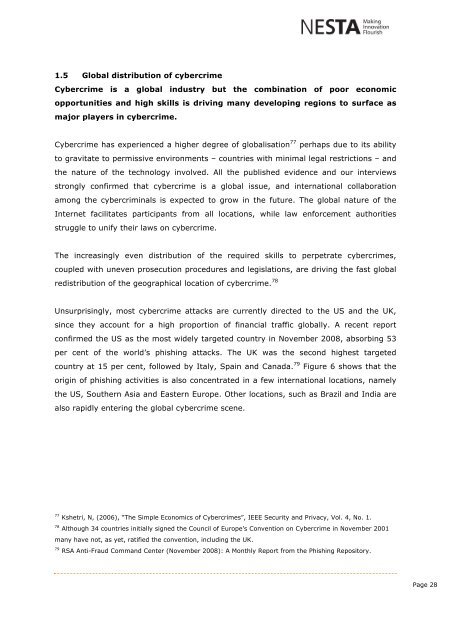NESTA Crime Online - University of Brighton Repository
NESTA Crime Online - University of Brighton Repository
NESTA Crime Online - University of Brighton Repository
Create successful ePaper yourself
Turn your PDF publications into a flip-book with our unique Google optimized e-Paper software.
1.5 Global distribution <strong>of</strong> cybercrime<br />
Cybercrime is a global industry but the combination <strong>of</strong> poor economic<br />
opportunities and high skills is driving many developing regions to surface as<br />
major players in cybercrime.<br />
Cybercrime has experienced a higher degree <strong>of</strong> globalisation 77 perhaps due to its ability<br />
to gravitate to permissive environments – countries with minimal legal restrictions – and<br />
the nature <strong>of</strong> the technology involved. All the published evidence and our interviews<br />
strongly confirmed that cybercrime is a global issue, and international collaboration<br />
among the cybercriminals is expected to grow in the future. The global nature <strong>of</strong> the<br />
Internet facilitates participants from all locations, while law enforcement authorities<br />
struggle to unify their laws on cybercrime.<br />
The increasingly even distribution <strong>of</strong> the required skills to perpetrate cybercrimes,<br />
coupled with uneven prosecution procedures and legislations, are driving the fast global<br />
redistribution <strong>of</strong> the geographical location <strong>of</strong> cybercrime. 78<br />
Unsurprisingly, most cybercrime attacks are currently directed to the US and the UK,<br />
since they account for a high proportion <strong>of</strong> financial traffic globally. A recent report<br />
confirmed the US as the most widely targeted country in November 2008, absorbing 53<br />
per cent <strong>of</strong> the world’s phishing attacks. The UK was the second highest targeted<br />
country at 15 per cent, followed by Italy, Spain and Canada. 79 Figure 6 shows that the<br />
origin <strong>of</strong> phishing activities is also concentrated in a few international locations, namely<br />
the US, Southern Asia and Eastern Europe. Other locations, such as Brazil and India are<br />
also rapidly entering the global cybercrime scene.<br />
77 Kshetri, N, (2006), “The Simple Economics <strong>of</strong> Cybercrimes”, IEEE Security and Privacy, Vol. 4, No. 1.<br />
78 Although 34 countries initially signed the Council <strong>of</strong> Europe’s Convention on Cybercrime in November 2001<br />
many have not, as yet, ratified the convention, including the UK.<br />
79 RSA Anti-Fraud Command Center (November 2008): A Monthly Report from the Phishing <strong>Repository</strong>.<br />
Page 28
















